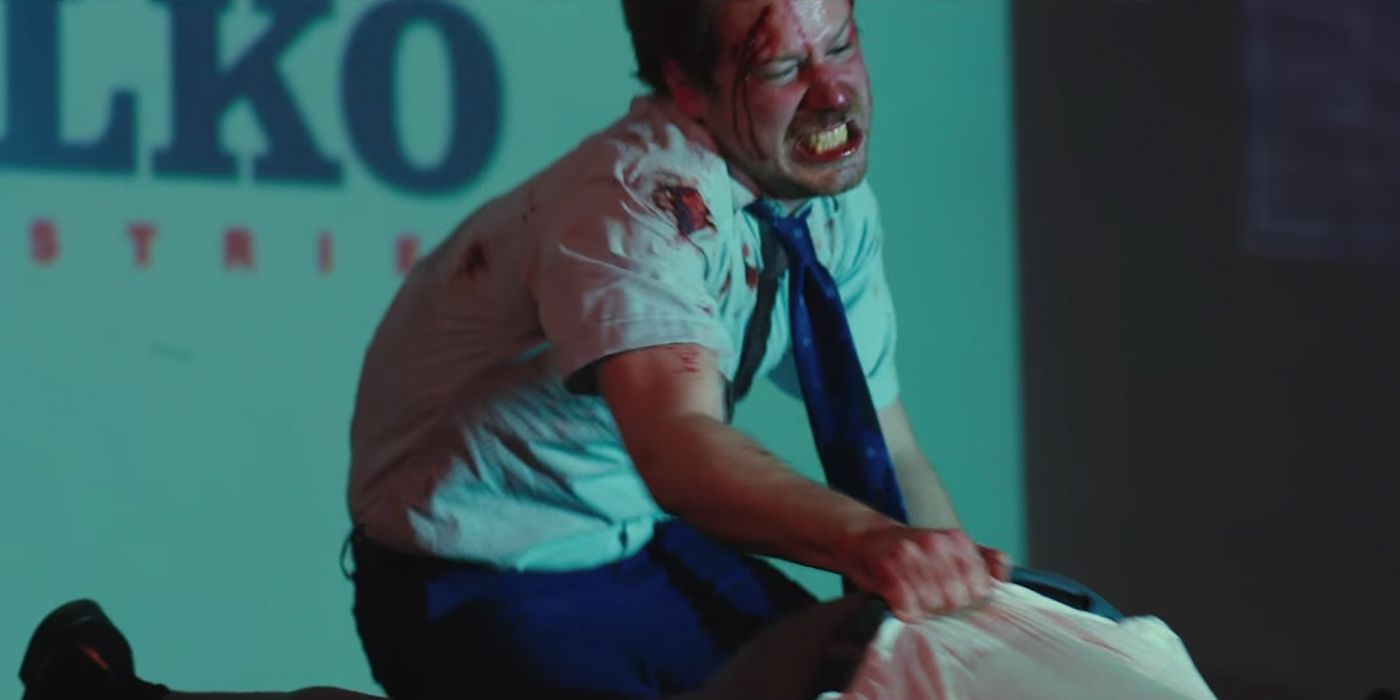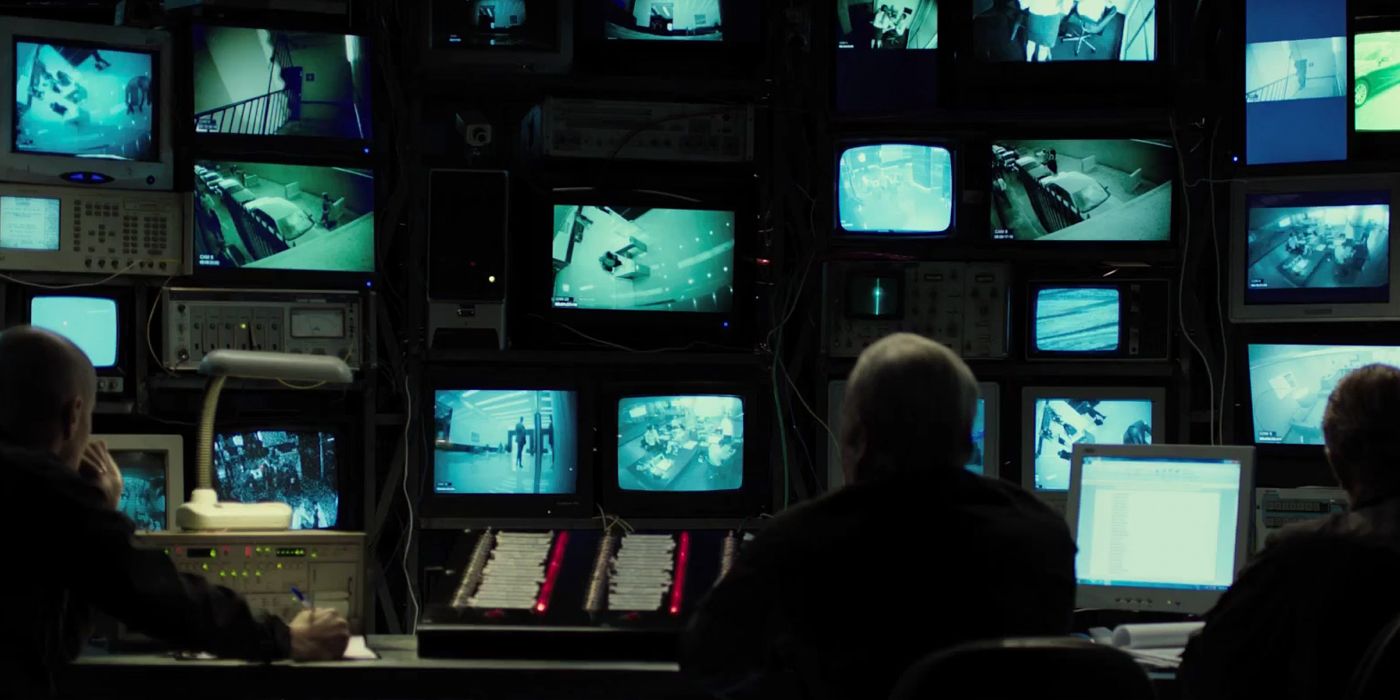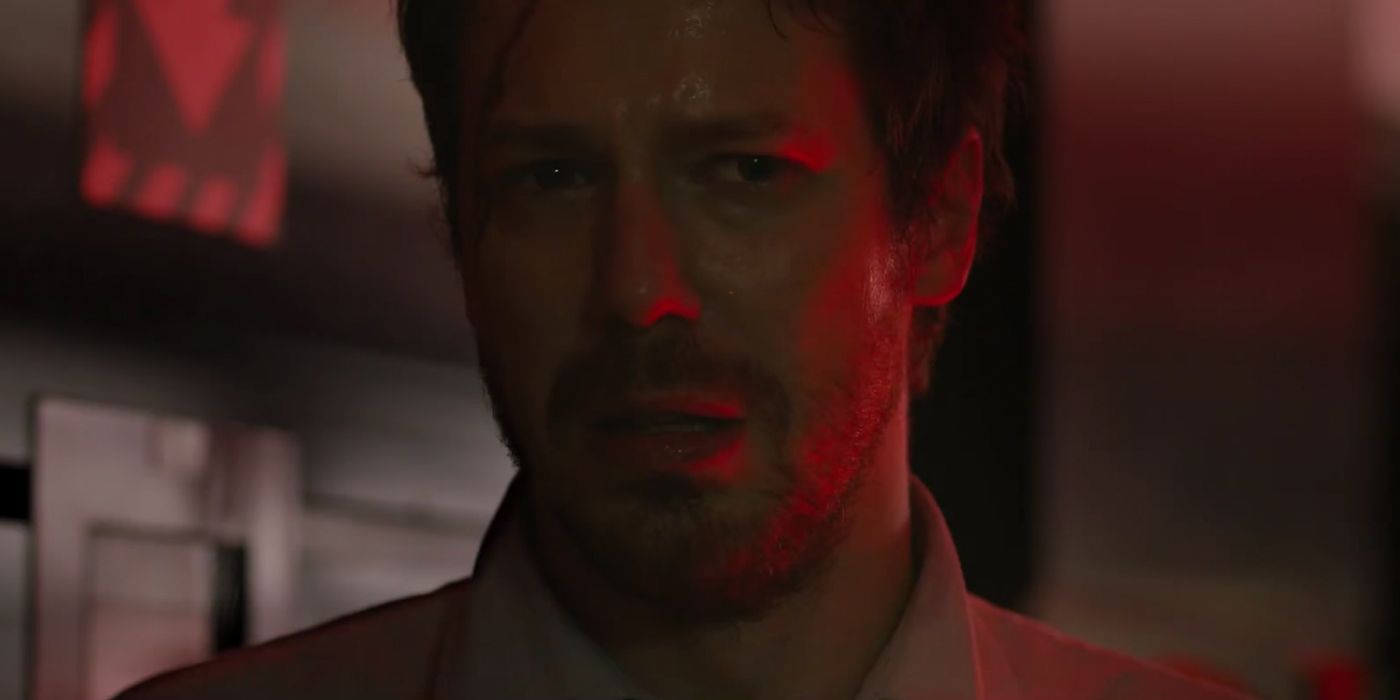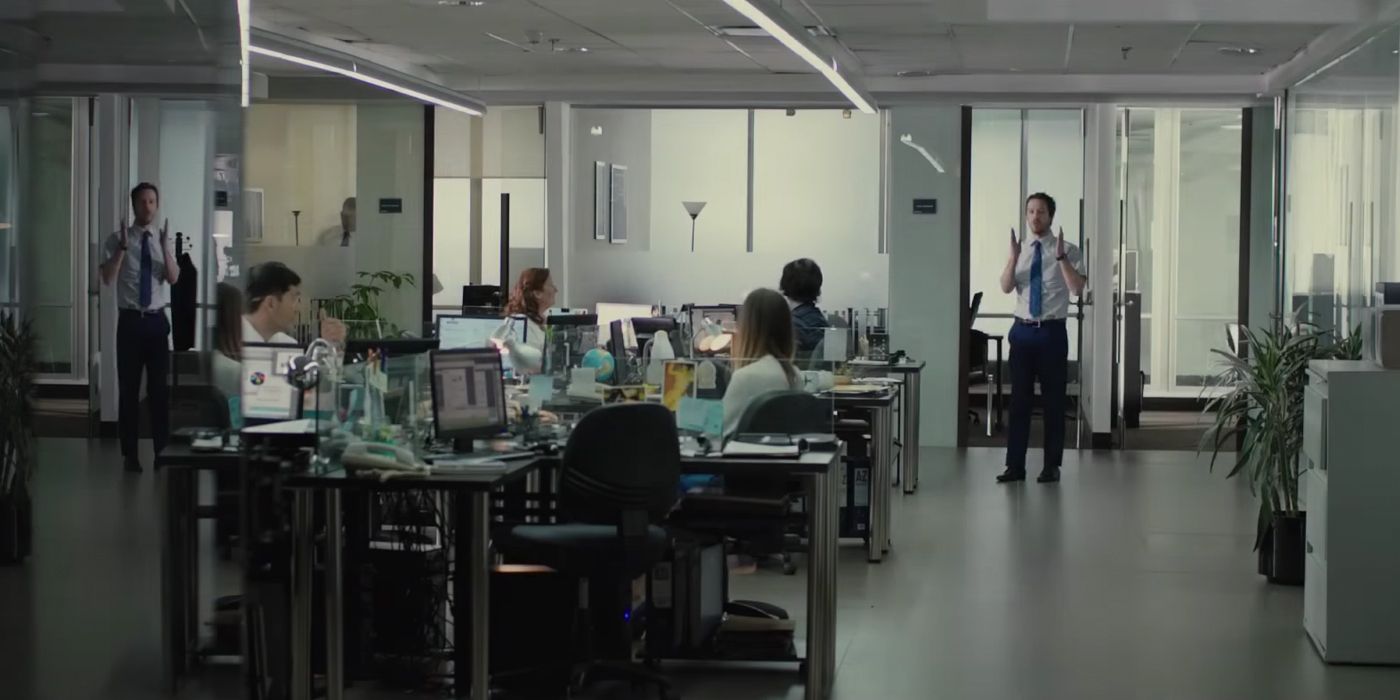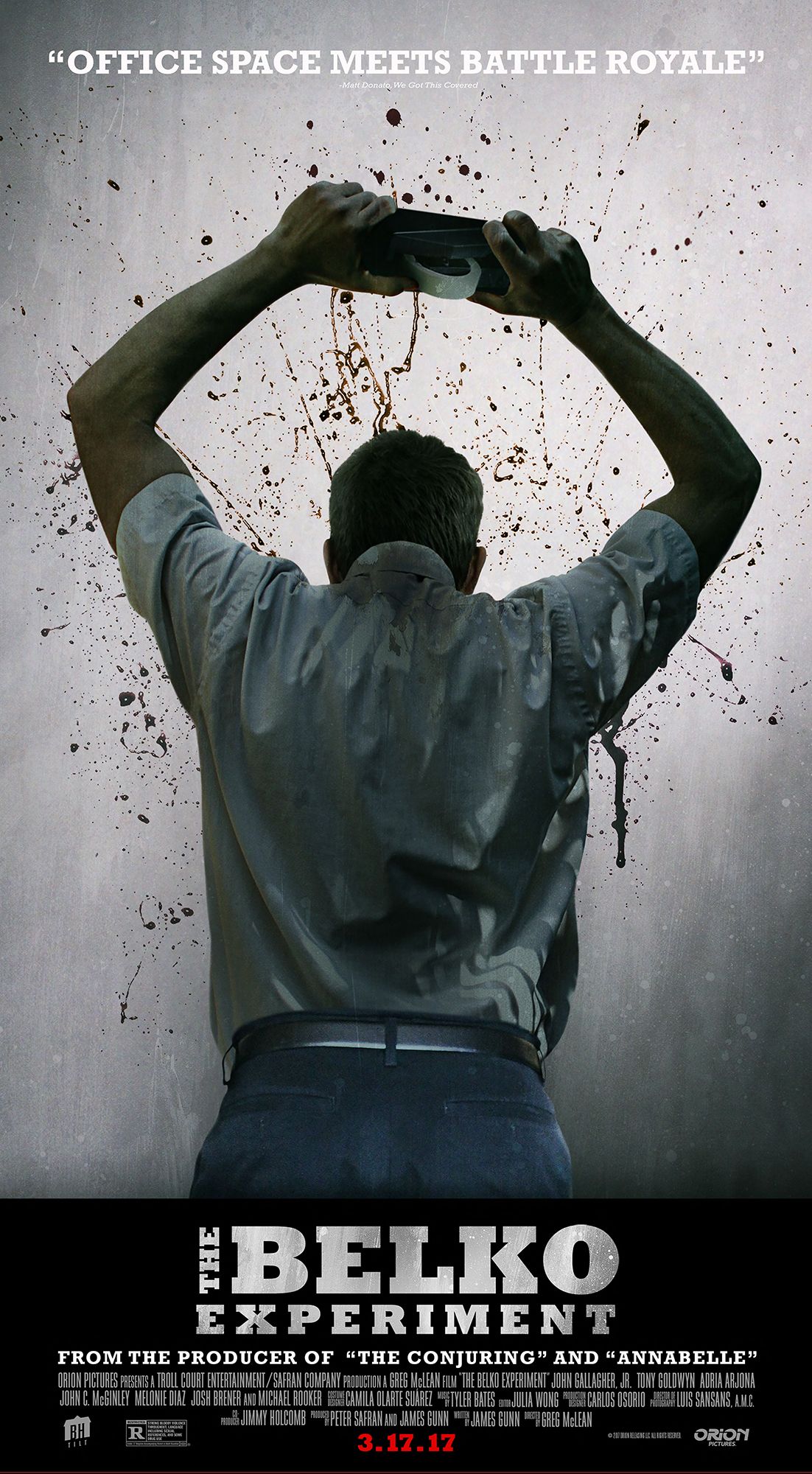Warning: Spoilers for The Belko Experiment ahead
-
If you could kill your co-workers, would you? That’s the basic premise working at the heart of The Belko Experiment. Greg McLean’s latest psychological thriller pits the employees of the mysterious Belko Industries (an impressive cast that belies the film’s low budget) against each other, with an unseen voice daring them to murder their colleagues before their new overlords kill double. The film mines this concept for all its worth, showing the gradual breakdown of the distressed workforce into fractured parties fighting to stay alive in their own unique ways.
Of course, this isn’t as simple as just being a gore-fest; there’s some sly social commentary at play and, to enable the story, writer James Gunn (who found time to script the film while directing Guardians of the Galaxy Vol. 2) has constructed a massive conspiracy behind the titular corporation.
Related: The Belko Experiment 2: Is It Happening or Not?
As a quick recap, at the end of the film, John Gallagher Jr.’s Mike Milch emerges as the lone survivor of the three phases of the experiment (to kill two people, to kill thirty people and to have made the most kills respectively). He’s taken by armed guards to meet "The Voice" a scarred suit played by Gregg Henry, who swiftly explains the whole thing as some form of social experiment before Mike manages to kill him and the guard. The final shot then reveals that he’s not alone in his experience, and is still being monitored as "Stage 2" begins. Needless to say, there's a lot going on, so let's take a deep dive into what happened and what it actually means.
What is Belko Industries?
Outwardly, Belko is a non-profit organization that helps South American companies hire US-national workers. The office seen in the film is based in rural Colombia and operated by a mixture of native workers and American immigrants. Through the eyes of new employee Dany we get a taste of their hiring procedure; after signing a contract that gives full power over to the corporation, each of the expats is fitted with a tracker that allows the company to find them should anything go wrong in the dangerous country (crucially, locals don’t have such precautions installed).
This extreme hiring and Day One process definitely limits the sort of people who work for the company. In the words of Roberto, no normal people work at Belko. Indeed, at least a handful of the standard employees are ex-special forces, and the implication is that relocation comes with a major cash payout. What sort of work the employees do beyond basic recruitment work isn’t divulged by the film, giving the job a generic feel, which also ties into how Belko Industries isn’t what it seems.
It’s only ever suggested in the movie by the employees, but it seems fair to assume that the company is a complete front with no actual business purpose. Their building is a government construction plated completely with thick, impervious metal – on the face of it to keep any dangerous parties out, but in intention and practice to keep people in – situated in a highly remote location. It is, in reality, all setup for the "experiment".
What Is The Experiment?
As becomes quickly apparent in the movie, Belko’s true purpose is to serve as the setting for an incredibly deadly sociological experiment. This is instigated by the arrival of mysterious armed security, a block of all forms of communication, a complete lockdown of the building itself and an announcement commanding the employees to kill each other. The unwilling subjects are forced to participate in the game by the trackers – they have an auxiliary (although it’s really their primary) purpose as bombs, able to explode at the flick of a button. With wall-to-wall monitoring, these are used as both a threat against any breaking of the “game’s” rules (dismantling cameras or trying to signal for help) and a punishment if the tasks of killing coworkers aren’t completed.
At the film’s climax, we finally get some semblance of an explanation - albeit a brief one. The Voice reveals he is part of an international organization made up of the greatest thinkers and social scientists in the world, who have used money and influence to create elaborate labs where they can perform complex experiments free from standard moral and societal confines.
This case appears to be, as Sean Gunn’s Marty posits, to examine how different people react under pressure - just a bit more extreme than he first theorized. Belko’s hiring practices mean they have plentiful information on each of the 80 participants’ backgrounds, and they’re able to manipulate the test base to fit their needs. The cast of the film spans all ages and seems to have a range of backgrounds, which in-universe is done to obtain a wide set of data. What data exactly is left unexplained, but we can assume is that it's rooted in a desire to analyze US citizens - the Colombian employees of Belko are sent home at the gates on the day of the experiment - and, from the final twist, weed out the most capable candidates.
What is Stage 2?
That’s still not quite the full picture, though, as the final shot reveals. After Mike has killed his captors, he stumbles outside and the angle shifts to a CCTV camera, revealing that he is actually still being watched. And he’s not the only one; the camera zooms out further to show collection of screens monitoring various lone survivors from similar experiences at other Belko locations around the world – at least 30 – when an eerie, new voice announces it’s time for “Stage 2”.
This reframes the previous explanation of what’s going on. While it’s definitely likely that The Voice was fully informed when he divulged the vague details of the organization and the experiment, his messing with a single office building was just a very small part of a much bigger plot. In fact, it seems that his death was somewhat predicted, or at the very least desired; Mike’s true success in the eyes of his new observers is that he was able to keep “playing” even after his announced victory in the office. Presumably if he hadn't killed The Voice and the soldiers, he would have been eliminated.
Instead, he lives to be part of Stage 2, which essentially means that what we’ve watched is just the start, with the real test still to come on a larger scale - the whole movie was basically a selection process to find who to put in the next game. We’ve already had hints at a grand conspiracy or government coalition through the building’s design and international corporation at the film’s core, but this suggests that the group of demented, self-proclaimed geniuses are working on a New World Order level and really messing with people.
This is a pretty satisfying end point, fitting of the film’s constant wrong-footing of the characters, but can also serve as setup for a sequel should the movie prove a big enough success; we could have the various survivors brought together into a more extreme, battle-hardened showdown. Think Catching Fire to the first’s Battle Royale. It’s definitely possible; The Belko Experiment cost only $5 million to make, so it doesn’t need to be a mega-hit to still make a tidy profit, and turning successes into franchise is pretty much prouducer Blumhouse's business model. While at the moment Stage 2 is a fun coda, it may become more important as time goes on.
Work Politics And American Globalization
The Belko Experiment uses its blood-soaked narrative to explore several interesting themes relating to modern life. It doesn’t do it quite as incisively as it perhaps thinks it is – you can only imagine how much darker a Black Mirror version of this story would go – but James Gunn certainly takes some deep dives.
The core exploration is the in-universe purpose of the experiment, seeing how various people deal with extremely high-pressured situations. We see the full range of reactions from the Belko employees to their commands, with John C. McGinley's Wendell Dukes wanting to immediately give in to the violence, Mike trying to explicitly escape, Sean Gunn’s Marty going full paranoid theorist and most others slotting somewhere in the triangle they form. The weight of whether you actually can take another person's life - regardless of if you think you can - looms over the characters until human survival instincts kick-in; eventually, even pacifists are forced down the dark path, with Mike letting his anger burst through when he repeatedly pummels COO Barry's face in with a tape dispenser.
Through the framing of the violence, the film not only poses a classic question, but gives a commentary on how big business operates. Even Barry finds himself powerless in the face of the change instigated by higher ups, unable to command his workforce in the panic and struggling to step up the bat when it comes to enacting his heartless plans. The whole Belko front can even be read as a sadistic take on how faceless corporations can fundamentally mess with their employees lives, pushing them further and further thanks to the emotional distance a tiered management structure enables.
Alongside that there’s also an exploration of globalization. This is evident from the very start following the employees driving to work in their high-end cars through the poor town of Bogotá, Colombia and hammered home by their job; they’re relocated Americans working to relocate more for ostensibly financial purposes. At first it seems like the film is attempting to simply redress the balance by showing the inherent barbarism underlying western civilization, but the final reveal that the whole thing is being orchestrated by an international organization twists things to highlight how unavoidable and deep-set multi-national conglomarates are. The suggestion seems to be that, in the high annals of business, that borders and nationalities cease to be a barrier, and moral decency doesn't even exist.

